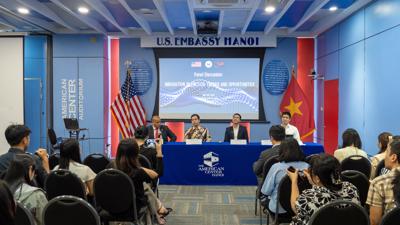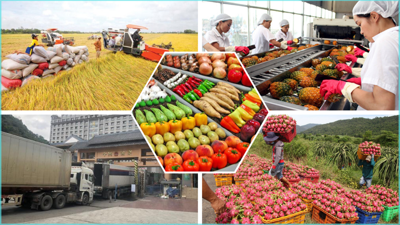The world awaits
The full lifting of restrictions on international flights from February 15 and the introduction of tourism stimulus programs augur well for the recovery of the aviation industry

Vietnam lifted restrictions on destinations and international flight frequency to and from Vietnam from February 15, according to the Civil Aviation Authority of Vietnam (CAAV). All Vietnamese and foreign airlines are now permitted to operate flights at frequencies and on routes based on bilateral and multilateral aviation agreements in place prior to the pandemic. People can now travel more easily, and with tourism stimulus programs being implemented around the country, aviation will be in better shape and may exceed pre-pandemic levels this year.
Restart for aviation
On the first day restrictions were lifted on international flights, Tan Son Nhat International Airport in Ho Chi Minh City welcomed only 1,245 passengers arriving on nine international flights from the US, Australia, Singapore, Turkey, Taiwan (China), and Cambodia. Hanoi’s Noi Bai International Airport catered to a total of 80 international flights, of which 23 were passenger flights, including 14 departures and nine arrivals. Arrivals totaled just 800 people and departures 1,200. Mr. Dinh Viet Thang, Director of the CAAV, said that although there are signs of improvement in international passenger transport, compared to before the pandemic, the numbers are unsurprisingly quite modest. “Many passengers are officials, experts, or Vietnamese returning home, and flights are yet to attract tourists in significant numbers,” he added.
However, other data from the CAAV shows that after a pilot of regular international flights was conducted in January, as of February 14, international passenger numbers arriving in or leaving Vietnam reached 153,000, or double the number during lockdown. Expectations of growing passenger numbers from the lifting of restrictions are therefore entirely warranted. International passengers are forecast to reach 13 million for the year as a whole; a substantial increase compared to the meager 200,000 welcomed last year.
The CAAV developed a range of plans to reopen regular international commercial flights in early 2022 after nearly two years of strict border closures. In January, there was a tentative reopening of flights to high-demand destinations such as Tokyo, Seoul, Beijing and Guangzhou, Chinese Taipei, Bangkok, San Francisco and Los Angeles, Vientiane, Phnom Penh, and Singapore, with limited frequencies.
Mr. Thang said the restoration of international flights to levels prior to Covid-19 is a pressing task. “During implementation, we will conduct regular reviews and evaluations, and now is the right time to reopen international flights after the two-month pilot,” he explained. “It is necessary to fully restore regular international flights so that airlines can proactively plan flight schedules and passengers have more flights to choose from.”

Seizing the day
Airline representatives said that reopening international flights is a prerequisite for the recovery and development of the aviation sector, as the international market accounts for a large proportion of their total revenue.
For example, international flights accounted for 63 per cent of the record VND100 trillion ($4.4 billion) in revenue posted by national flag carrier Vietnam Airlines in 2019, or VND63 billion ($2.8 billion). At Vietjet Air, the proportion of revenue from international routes also accounts for more than 50 per cent. The accumulated financial and property resources of airlines have been exhausted, which has pushed many to the brink. In anticipation of recovery, airlines, airports, and flight management companies had been preparing since mid-2021 to gradually operate once more in the fourth quarter, initially domestically and then internationally.
Therefore, as soon as international flights were piloted in January, Vietnam Airlines was ready to conduct regular flights to Vietnam. It is expected that, from April, the national flag carrier will increase flight numbers on its international network to at least 95 a week and from July to at least 164. Under this plan, its entire international flight network will be restored to levels prior to the pandemic. “The fact that Vietnam has not limited the frequency of international flights to all markets from February 15 is a favorable premise for carriers to restore and expand their flight networks and prepare to meet international tourism demand in the near future,” a representative from Vietnam Airlines said.
In addition to plans to exploit key domestic markets, Bamboo Airways intended to operate and actually increase the frequency of international flights from the beginning of 2022. Believing in the potential of Vietnam’s aviation market to recover strongly, it continues to propose increasing its fleet from the current 29 aircraft to 100 by 2028 and to raise total investment capital from VND5.7 trillion ($253 million) to VND14.8 trillion ($657 million). “Bamboo Airways plans to expand its flight network to nearly 80 domestic routes and nearly 40 international routes, meeting the travel needs of domestic and foreign passengers, and at the same time contribute to connecting Vietnam with other countries and territories around the world,” said Mr. Dang Tat Thang, General Director of Bamboo Airways.
Following approval from governments and authorities, Vietjet Air also had a plan to resume regular international flights from January 1. It will continue to increase the frequency of regular international flights connecting Vietnam and existing destinations. Flight frequency to South Korea and Taiwan (China) is expected to increase to five round-trip flights a week, to four round-trip flights a week to Japan and Singapore, and to three round-trip flights a week to Bangkok. The carrier also plans to reopen other routes in the region and beyond, such as India and Russia.
Mr. Thang said that amid difficulties are always opportunities. “There is no better opportunity than now, and airlines need to prepare their resources to immediately make the most of the reopening,” he added.

Infrastructure a stumbling block
Though the opportunities are many, infrastructure may present a new obstacle in the recovery and development plans of the aviation industry. During the recent Lunar New Year (Tet) holiday, travel demand rose dramatically, exceeding the forecast from CAAV. There were many instances of congestion, especially at Tan Son Nhat International Airport, with the number of passengers reaching a record 100,000 arriving and departing on more than 670 flights; equal to pre-pandemic levels.
While optimistic about the prospects for the aviation industry in 2022, aviation expert Associate Professor Dr. Nguyen Thien Tong is concerned that growth may be too strong while State management may be a little slow, and that infrastructure may be unable to meet passenger demand.
Referring to the temporary closure of runway 25R/07L at Tan Son Nhat for repairs and upgrades until March 15, Dr. Tong expressed confusion regarding the closure just as routes reopen and airlines and travel companies rush to get back in business, instead of conducting these repairs and upgrades during the pandemic.
In addition, the airport’s land area is and always has been tight, while a neighboring golf course sits on nearly 160 ha, featuring high-end entertainment services, a conference center, a 5-star hotel, and residences for rent. “It is necessary to reclaim this land, which has been occupied for more than ten years,” he said.
Furthermore, to ease the overload at Tan Son Nhat, the construction of passenger terminal T3 must begin as soon as humanly possible. While the investment policy was approved by the government in May 2020 and construction was slated to get underway in December 2021, with total capital of about VND10.99 trillion ($488 million) from the Airports Corporation of Vietnam (ACV), the project is currently moving along very slowly.
Meanwhile, Long Thanh International Airport, which will serve Ho Chi Minh City and the south in general, remains as far off as ever. Even once it is put into operation, Long Thanh will face obstacles in terms of traffic links, which are not as handy as for Tan Son Nhat. “Tan Son Nhat will remain the leading airport in Vietnam and a key international gateway,” Dr. Tong said. “It is necessary to attract private enterprises to participate in infrastructure, such as Vietjet Air and Bamboo Airways, instead of simply handing everything over to ACV.”







